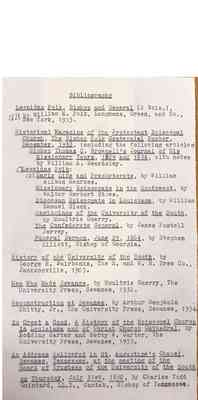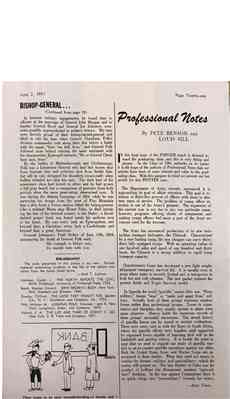Pages That Mention New York
Polk Family Papers Box 1 Document
2
Mr. Toastmaster, Bishop Donegan, Bishop Boynton, Dr. McCrady, Right Reverend, Very Reverend and Reverend Sirs, General Crittenberger, Mr. Duncan, Members of the John H.P. Hodgson Chapter of the Associated Alumni of the University of the South, Gentlemen of Sewanee, and distinguished guests:
I have always known that my brother, the Suffragan Bishop of New York, was a man of wide experience but I had never realized until this evening the extent and the intimacy of his contacts in Ireland!
In the year 1839 when Bishop Polk was making his first episcopal visitation as Missionary Bishop of the Southwest, it is recorded that he had some rough experiences. The Republic of Texas had at that time a reputation for being a place of refuge for insolvent debtors and fugitives from justice, and the Bishop was suspected of belonging to one or the other of those classes. A rough and ready Texan, hearing that the Bishop was one of the Polks of Tennessee, said to him, "Well, stranger, if it is a fair question, I would give a heap to know what brought you here!"
34
BIBLIOGRAPHY
Leonidas Polk, Bishop and General (2 Vols.), by William M. Polk, Longmans, Green, and Co., New York, 1915.
Historical Magazine of the Protestant Episcopal Church, The Bishop Polk Centennial Number, December, 1938, including the following article's: Bishop Thomas C. Brownell's Journal of His Missionary Tours, 1829 and 1834, with notes by William A. Beardsley. Leonidas Polk: Early Life and Presbyterate, by William Wilson Manross. Missionary Episcopate in the Southwest, by Walter Herbert Stowe. Diocesan Episcopate in Louisiana, by William Samuel Slack. Beginnings of the University of the South, by Moultrie Guerry. The Confederate General, by James Postell Jervey. Funeral Sermon, June 29, 1864, by Stephen Elliott, Bishop of Georgia.
History of the University of the South, by George R. Fairbanks, The H. and W. B. Drew Co., Jacksonville, 1905.
Man who Made Sewanee, by Moultrie Guerry, The University Press, Sewanee, 1932.
Reconstruction at Sewanee, by Arthur Benjamin Chitty, Jr., The University Press, Sewanee, 1954.
So Great a Good, A History of the Episcopal Church in Louisiana and of Christ Church Cathedral, by Hodding Carter and Betty W. Carter, University Press, Sewanee, 1955.
An Address delivered in St. Augustine's Chapel, Sewanee, Tennessee, at the meeting of the Board of Trustees of the University of the South, on Thursday, July 31st, 1890, by Charles Todd Quintard, LL.D., Cantab., Bishop of Tennessee.
Polk Family Papers Box 1 Document 12
3
June 2, 1961 Page Twenty-one
BISHOP-GENERAL...
(Continued from page 19)
In between military engagements, he found time to officiate at the marriage of General John Morgan and to baptize General Hood and General Joe Johnston, occasions possibly unprecedented in military history. His men were fiercely proud of their bishop-turned-general and liked to cite the time when General Cheatham, Polk's division commander rode along their line before a battle with his usual. "Give 'em hell, boys," and General Polk followed close behind echoing the same sentiment with his characteristic Episcopal restraint, "Do as General Cheatham says, boys."
By the battles of Mufreesborough and Chickamauga, Polk was a Lieutenant General who had had horses shot from beneath him and orderlies shot from beside him, but still he only shrugged his shoulders occasionally when bullets whistled too near his ears. The dark hair of his missionary days had turned to silver and he had grown a full gray beard, but a comparison of portraits from both periods show the same penetrating, determined eyes. It was during the Atlanta Campaign of 1864, while he was surveying his troops from the crest of Pine Mountain that a shot from a Union cannon felled the bishop-general. Like a militant Moses atop Mount Nebo, he died intrusting the fate of his beloved country to his Maker; a bloodstained prayer book was found inside his uniform next to his heart. He was every inch an Episcopalian, and beyond that, a Christian; every inch a Confederate, and beyond that, a great American.
General Johnston's Field Orders of June 14th, 1864, announcing the death of General Polk read, His example is before you; his mantle rests with you. _______
BIBLIOGRAPHY The work presented in this article is my own. Factual material concerning incidents in the life of the subject was taken from the books listed below. —Emil T. Lechner.
Andrews, Cutler J. THE NORTH REPORTS THE CIVIL WAR, Pittsburgh: University of Pittsburgh Press, 1955.
Benet, Stephen Vincent. JOHN BROWN'S BODY, New York: Holt, Rinehart and Winston, 1960.
Dowdey, Clifford. THE LAND THEY FOUGHT FOR, Garden City, N. Y.: Doubleday and Company, Inc., 1955.
Polk, William M. LEONIDAS POLK, Volumes I and II, New York: Longmans, Green, and Company, 1893.
Pollard, E. A. THE LIFE AND TIMES OF ROBERT E. LEE, New York: E. B. Treat and Company, 1871.
Polk Family Papers Box 1 Document 17
1
[5 photographs in frames]
Photo POLK BF
{text from top left photo} Bishop Polk Entered according to Act of Congress in the year 1862, by M.B. Brady in the Clerk's office of the District Court of the U.S. for the [?] District of New York.
{below lower center photo} ↖ Coulson 59-2259 almost like above



